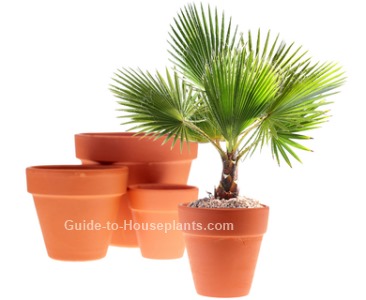Windmill Palm Tree Care
Dramatic fan-shaped fronds lend Windmill Palm Tree instant excitement that few indoor palm plants can match. Give this spectacular houseplant a special spot where it will be admired -- it's sure to capture attention.
This palm tree also happens to be one of the easiest to please indoors. Here, you'll discover how to care for Windmill Palm, including how much light it wants year-round, when to water, what to know about repotting, why you want to "flush" your palm tree, and more houseplant help.
Get to Know Windmill Palm
Windmill palm tree is known by the botanical name Trachycarpus fortunei.
Upright fronds of spiky leaflets make it a stunning decorative accent. Young fronds have pleated leaflets that gradually open into widely spaced fans.
As the palm grows, it develops a thick trunk which is covered with coarse brown fibers.
How tall will it get? A giant in its native habitat of Southeast Asia, this captivating indoor palm plant only reaches 6-8 ft when grown in a container indoors. Slow-growing, it will take several years to reach this height.
Shed some light. Give this palm as much light as you can. Move it outdoors for the summer, if you want. Just be sure to keep it protected from strong winds, which can damage the fronds. A sheltered porch or patio is ideal.
Keep fronds clean. Upright leaves are sometimes dust-catchers. Wipe them off with a damp cloth.
When to Repot Windmill Palm
Your young palm tree will likely need repotted every 2-3 years as it grows.
Don't be in a hurry to repot. Although slow-growing, Windmill Palm Tree can grow up to 8 ft tall indoors. You can keep it in the same pot for years, if you want. Crowding roots helps to control its size.
Use a heavy container to prevent it from toppling because this palm gets top-heavy. Take care not to over-pot -- move it to a pot 1 size (1 to 2-inches) larger. Why? A pot that's too big will hold too much water, leading to root rot.
It's a good idea to use a pot with drainage holes to prevent soggy soil. You can keep your new palm plant in the nursery pot, if you like. If you want to cover up a plain pot, drop it in a cachepot (a decorative pot without drainage holes).
Spring is the best time to repot a houseplant, when it is beginning its most vigorous time of growth.
Older plants that are too big to repot can be top-dressed instead by replacing the top couple inches of soil.

Buying a palm? Windmill Palm Tree sometimes goes by the common names Chusan Palm or Fortune Palm. Look for the botanical name Trachycarpus fortunei to be sure you're getting this indoor palm plant.
Windmill Palm Tree Care Tips
Light: Bright light with plenty of direct sunlight. Moving your palm outdoors? Make the move a gradual one. Palms that go into hot, direct summer sun then back to indirect light indoors may drop their leaflets.
Water: Keep soil moist spring through summer and barely moist in fall and winter.
Humidity: Moderate (at least 50% relative humidity). Dry air will cause the tips of the leaflets to turn brown and crispy. The easiest and most efficient way to raise humidity around your tropical houseplants is with a cool-mist room humidifier.
Temperature: Average room temperature 65-75°F/18-24°C year-round. This is one of the few "indoor palms" that can tolerate cold. Windmill palm loves warmth, but will tolerate a minimum of 40°F/4°C in winter.
Soil: Use a peaty mix that drains well. Mix 1 part horticultural sand to 3 parts African violet potting mix.
Fertilizer: Feed once in spring and again in summer with a time-release fertilizer made specially for palm trees. Rose fertilizer also works well because it provides the micronutrients this palm needs. A shortage of magnesium will cause yellow spots on the leaflets.
Propagation: Plants can be grown from seeds, but seedlings are slow-growing and you'll wait several years for them to grow into trees.
Windmill Palm Tree Problems, Solutions and Houseplant Helps
Brown leaf tips are often caused by sporadic watering, low humidity, or a build-up of chemicals in tap water and fertilizers. It's a good idea to water palms with distilled, filtered or rain water.
How to Flush Your Potted Palm Tree
Palms are sensitive to fluoride and chlorine often found in tap water, and salts from fertilizer. You can get rid of these impurities in the soil by flushing the container. It's easy to do: Pour lots of water over the soil so that the water comes out the drainage holes. Repeat the process a couple more times, then empty the drainage tray.
Something bugging your indoor palm? Among the possible pests that attack palms are mealybugs, scale insects, and spider mites. Watch for these pests and treat any infestation right away.
Small fronds? They may be young. If new leaflets stay small, your palm tree may need more sunlight. If you haven't been feeding your houseplant, it's time to give it the nutrients it needs to grow. See "Fertilizer" tip above.
Brown fronds are sometimes a symptom of dry soil. However, it's natural for old fronds to turn brown. Cut off brown fronds with sharp, clean pruners.

